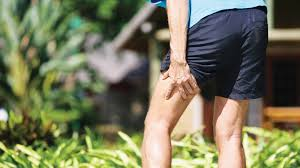
How the injury happens may be different depending on when you hurt your hamstring. An acute strain can occur in training or a match with sudden acceleration, sprinting, sharp change in direction or hard breaking and sliding into a tackle (overstretching the hamstring muscle).
The hamstring muscle works over the hip and knee, and as such is a two-joint muscle. It contracts to extend the hip, straightening the leg or pulling it back behind you; and it flexes or bends the knee.
The hamstring is therefore constantly working throughout all stages of walking or running and jumping allowing little time for rest or recovery. It is susceptible to fatigue, which makes it vulnerable to injury. A common consequence of this is straining the hamstring in the latter half of a game as it starts to tire, especially if you are not well conditioned! A previous hamstring strain is the biggest risk factor for a future hamstring injury.
Physiotherapy is an integral part of treating a hamstring injury, both acute and overuse injuries. The sooner you start treatment following an injury the better the outcome. The early stages of treatment are not only aimed at reducing pain and swelling, but are also crucial to minimise scar tissue formation and ensure good muscle fibre alignment – which in the long term will ensure a stronger muscle, more resistant to injury.












